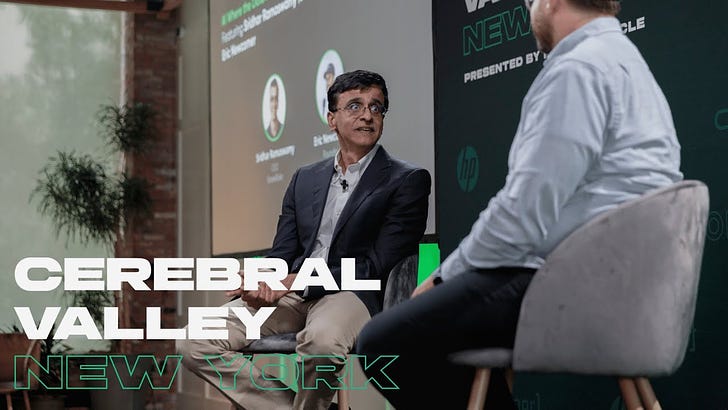7 Videos from Cerebral Valley New York: Snowflake CEO, Lambda CEO, Goldman CIO, Runway CTO & More
Listen to our on stage conversations from Cerebral Valley New York
We hosted our first Cerebral Valley AI Summit in New York last week, and we have seven conversations from the day to share with you.
Subscribe to the Newcomer YouTube channel and stay tuned for more highlights. We’ll be back with the rest of the talks from the summit later this week.
Snowflake’s CEO on Why He Thinks Customers Will Want to Bring AI to Their Data
Start off with our conversation with Snowflake CEO Sridhar Ramaswamy. He explains his decision to sell Neeva to Snowflake and how he never expected to become Snowflake’s CEO.
We ask him about rival Databricks’ acquisition of Tabular and what a public company CEO thinks about the possibility of artificial general intelligence.
Thousands of enterprises around the world rely on Oracle Cloud Infrastructure (OCI) to power applications that drive their businesses.
OCI customers include leaders across industries such as healthcare, scientific research, financial services, telecommunications, and more.
NVIDIA AI Enterprise brings the software layer of the NVIDIA AI platform to OCI, accelerating the data science pipeline and streamlining development and deployment production-grade generative AI applications. It includes NVIDIA NIM™, a set of easy-to-use microservices for accelerating the deployment of generative AI models across the cloud, data center, and workstations.
Talk with Oracle about accelerating your GPU workloads.
Goldman’s Multi-Model Generative AI Strategy
Goldman Sachs’ Marco Argenti isn’t giving any one foundation model company too much power. There will be no one foundation model that wins out over others. Argenti envisions a new common scenario of model “orchestration,” where an employee could send a task first to a larger, more general-purpose model and then fine-tune the work step-by-step with smaller, more specialized models.
Generative AI Has Tougher Margins than SaaS
Check out Volley co-founder James Wilsterman’s conversation with Vectara CEO Amr Awadallah, Lambda CEO Stephen Balaban, and Modal CEO Erik Bernhardsson.
The three had a lively debate around where the enterprise value will come in the coming years, with Balaban arguing that AI applications will not see the same high SaaS-like margins for quite a while due to the cost of running AI tools.
“Running an AI application is very compute intensive. And it's not at all like serving a web app,” said Balaban.
AI Agents in the Workplace
During this year’s summit, we tried something new with our breakout discussion groups, which let guests share their thoughts with AI experts and become part of the agenda for the day.
Lux Capital’s Grace Isford moderated a conversation on AI agents, and broke down how businesses are experimenting with different use cases for the new tech.
The Case for Open-Source From Meta, Databricks & Allen Institute for AI
Jonathan Frankle, Databricks’ chief AI scientist, argued against the broad necessity for large foundation models. “I don’t think we should care about models that try to do everything unless you want one very expensive thing that is pretty good at lots of things, including your task, as opposed to one very cheap thing that is really good at your one task,” said Frankle.
Open source can also be a savvy business strategy, Ali Farhadi of the Allen Institute for AI and Meta’s Laurens van der Maaten noted.
Runway’s Co-Founder Predicts Hollywood’s Embrace of AI
When it comes to the future of Hollywood, Runway co-founder Anastasis Germanidis predicted on-stage with Volley’s Max Child that we’re only two years away from video models that can generate feature-length films. “Now, you’re able to turn an idea for a spec for an advertisement or a short film into a real output in the course of a day instead of needing a week,” he said.
He also shared a demo of Runway’s latest video foundation model called “Gen-3 Alpha,” a sharp step up in detail and realism that’s now currently live. Germanidis envisioned scenarios in which this new model could generate video content that “simulates the experience of being on set” as a supportive tool for filmmakers.
How AI Democratizes Creativity
Recraft’s Anna Veronika Dorogush and Suno’s Mikey Shulman pitched optimistic visions of a not-so-distant future where anyone could create art or music with AI.
The two saw their tools in collaboration more with existing creative industries rather than in conflict. Despite Suno’s ongoing lawsuits with record labels, Shulman argued that generative AI can make music more collaborative.
Dorogush noted that many of Recraft’s users are design professionals, and use the generative tool to as part of their work. “We want to make creativity and innovation in the design space simple,” she said.






